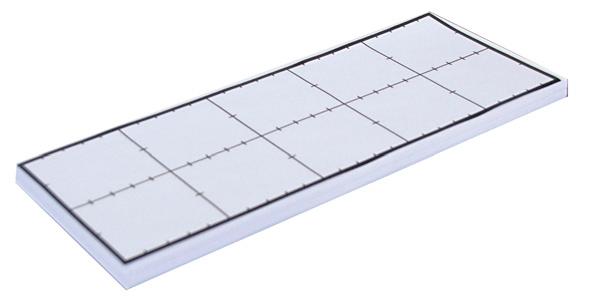Diagnostic questions
- Give the student four pieces of paper with the numbers 0.5, 1.99, 2.5, and 1.0 written on them. Ask the student to place the numbers in order of size.
- Ask the student to position the numbers on a number line.
What to notice in the student’s response
Can the student place the numbers in order?
Do they attend to the whole numbers first, or do they order the numbers based on how many digits they have?
Do they know that 0.5 is located halfway between 0 and 1?
Deliberate acts of teaching
Materials
- Decimats (Material master 7-3) (PDF, 82KB)
- Long strips of paper
- Sticky notes
The most effective way to learn new information is to make connections with existing knowledge. In these exercises, a 0–10 number line is compared to a 0–100 number line and a 0–1 number line.
Place It! Label It!
Construct a large number line (at least 1 metre long) representing values from 0 to 10. Mark the halfway point and ask the student to label it. Mark the halfway points between 0 and 5 and between 5 and 10, asking the student which number goes at each point. If necessary, use decimats to model half of 5 wholes. Write in the whole numbers between 0 and 10.
Give the student sticky notes with various decimal numbers written on them and ask them to place them on the number line. Encourage the use of benchmarks to make decisions, for example, “3.2 would be a bit less than halfway between 3 and 3.5.” Give the student practice with this number line for a few days, asking them to place decimal numbers on it and to label different points.
Create a number line the same length as the first one, representing values from 0 to 100. With the student, mark in the halfway points (50, then 25 and 75).
Place one number line below the other and compare the values of the halfway points. Discuss the relationship between 7.5 and 75.
Ask the student to find halfway points between several pairs of consecutive whole numbers. Give the student values to place on the number line and places to label with values.
Make a third number line the same length as the other number lines, representing values from 0 to 1. Discuss with the student where the halfway points will be and use a decimat to check their values.
Place the 0–1 number line above the 0–10 number line and compare 0.25 to 2.5. Discuss how the change in scale has impacted on the place value of the 2 and the 5.
Compare the shift in scale to looking at a single section of a number line through a magnifying glass.
What to do next if the student is stuck
Continue working with the 0–10 number line. Model each number. Give the student repeated practice placing values on the number line and labelling points.
Initiating home-based activities
Provide a tape measure and ask the student to make linear measurements in their home environment, for example, heights of family members or the lengths and widths of windows.
Next teaching steps back in the classroom
Measurement work, particularly length, is useful in strengthening the concept of number lines.


